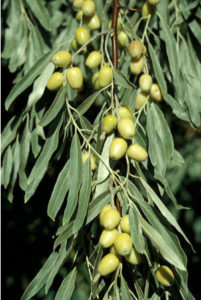Description
 Russian Olive can grow in dense shrubs that out-compete other native species. Although the berries provide food for birds, this invasive species reduces biodiversity.
Russian Olive can grow in dense shrubs that out-compete other native species. Although the berries provide food for birds, this invasive species reduces biodiversity.
ID
Russian Olive (Elaeagnus angustifolia) grows as shrubs to small trees and are covered with thin silvery leaves, which are alternate along the stem. It has yellow flowers in the spring and forms yellow-green fruit.
Management
Young seedlings can be pulled manually, but once they are larger the cut stumps must be painted with Glyphosate in order to kill the plants. Foliar spray and herbicides applied to the base of the trunk can also be an effective method of controlling this invasive species.
Alternatives
Once Russian Olive is removed, native plants can be planted that also have berries. These include High-bush Blueberry, Viburnum Nudum (Witherdod), and Winterberry Holly.